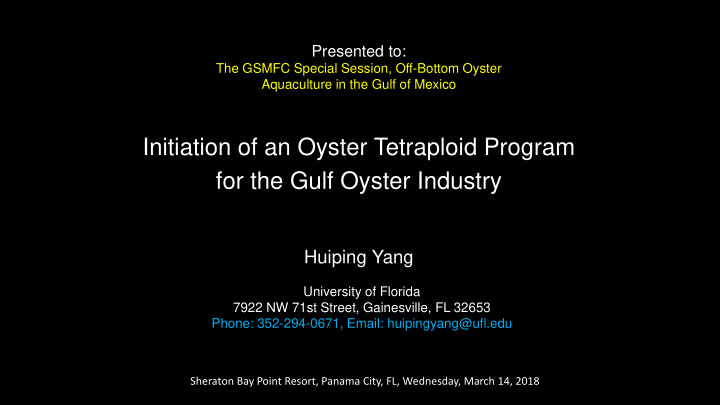



Presented to: The GSMFC Special Session, Off-Bottom Oyster Aquaculture in the Gulf of Mexico Initiation of an Oyster Tetraploid Program for the Gulf Oyster Industry Huiping Yang University of Florida 7922 NW 71st Street, Gainesville, FL 32653 Phone: 352-294-0671, Email: huipingyang@ufl.edu Sheraton Bay Point Resort, Panama City, FL, Wednesday, March 14, 2018
Acknowledgements The Gulf States Marine Fisheries Commission (GSMFC) Industry organizations - Florida Shellfish Aquaculture Association - Cedar Key Aquaculture Association Industry collaborating farms - Southern Cross Farm, Cedar Key, FL - Bay Shellfish Inc., Terra Ceia, FL - Clamtastic Seafood Inc., Cedar Key, FL - Cedar Key Seafarms, Cedar Key, FL - Northwest Gulf Seafood Farms, Wakulla, FL - Mr. Bill Lartz’s farm, Alligator Harbor, FL - Pensacola Oyster Company, Pensacola, FL - Oyster Mom, Inc., Wakulla, FL Graduate/undergraduate students, and staff - Natalie Simon - Cher Nicholson - Keegan Kelly - Erangi Henkeenda - August J Planmann - Yangqing Zeng - Anthony Boullosa
Oyster Industry in Florida Fishery landing has been dramatically decreasing since 2012 for example, 2016 fishery landing 0.56 million pound. Oyster aquaculture is growing rapidly Oyster farming: Over 400 acres (some leases claim hard clams and oysters) Florida has established infrastructure for shellfish farming Hatchery: 9 list “hatchery” as their business Nursery: 31 Growout: ~300
Triploid Oysters – Preferred by the industry Fast growth In Florida, it was reported triploid need about 8 months to reach market size. May also alleviate the fouling on oyster shells Better meat-quality especially in hot summer, thus can be year- round harvest No environmental pressure
To produce commercial triploid seed Tetraploids are Needed - Use for 100% triploid production - Application in several oyster aquaculture species in the US and worldwide - Tetraploid oysters in the Gulf region
An Oyster Tetraploid Program – Flow Chart Triploid Production The current by (2n ♀ x 2 n ♂ ) plus inhibition of polar body 1 project (PB1) or polar body 2 (PB2) Tetraploid Founder Production by (3n ♀ x 2n ♂ ) plus PB 1 inhibition Tetraploid Number Expansion (4n ♀ x 4n ♂ ) with (3n ♀ x 2n ♂ ) plus (2n ♀ x 4n ♂ ) plus no PB inhibition PB 1 inhibition PB 2 inhibition Tetraploid Breeding Populations originated from different geographical populations
Spawning and Treatment 1) Broodstock were collected from six locations in Florida Port Charlotte, Sarasota, Cedar Key, Wakulla, Alligator Harbor, and Pensacola Bay 2) From March to May, we made 11 field spawning trips with 24 spawning trials
Triploid Larval Production and Survival 1) Triploid larvae were produced with 20-70% in all of the 24 spawns 2) Larvae in five groups were survived beyond metamorphosis - spat
Triploid Seed Harvest for Grow-out Culture Triploid seed were harvested in three groups, and triploids were confirmed individually Spawning Broodstock Seed number Triploid (%) Labelling Date source (estimated) (Date to test) 2017CK1 April 5, 2017 Cedar Key ~30,000 38 (06/08/2017) 2017WA1 May 4, 2017 Wakulla ~20,000 57 (06/28/2017) 2017CK2 May 30, 2017 Cedar Key 15,525 53 (07/19/2017)
Mr. Curtis Hammel, Bay Shellfish Co.
Ploidy Determination - Protocol for ploidy determination was developed by using propidium iodide (PI) staining with flow cytometry. - Larvae: pooling sample - Spat: whole soft tissue - Adult: Tissue
Triploid (%) Broodstock Labelling Number Location (Date) Cedar Key 2017CK1 5,000 54% (11/08/2017) Southern Cross Sea Farm 76% (11/07/2017) Bay Shellfish Inc. 64% (10/31/2017) Oyster Mom Inc. Wakulla 2017WA1 ~20,000 54% (10/04/2017) Cedar Key Seafarms Southern Cross Sea Farms Cedar Key Seafarms Cedar Key 2017CK2 17,766 62% (10/23/2017) Pensacola Oyster Company Northwest Gulf Seafood Farms
Project Outcome 1) A total of 38,000 of chemically induced putative triploids were produced – the first step for a tetraploid program. 2) Industry participation and collaboration were developed. 3) Students and staff were trained - Oyster spawning, fertilization, polyploid induction, larval culture, and ploidy determination. 4) Extension materials and publications 1) Triploid and Tetraploid Oyster Production. PPT presentation. Presented to the hatchery staff and students during spawning trips. 2) Huiping Yang, Natalie Simon, and Leslie N. Sturmer. Production and Performance of Triploid Oysters for Aquaculture (in review). UF Electronic Data Information Source of UF/IFAS Extension. 3) Huiping Yang, Natalie Simon, Erangi Heekenda. 2017. Initiation of a Tetraploid Induction Program for the Oyster Industry, Florida Sea Grant Coastal Science Symposium, September 26, Gainesville, Florida.
Thank you! https://molluscanshellfishresearch.wordpress.com/
Recommend
More recommend